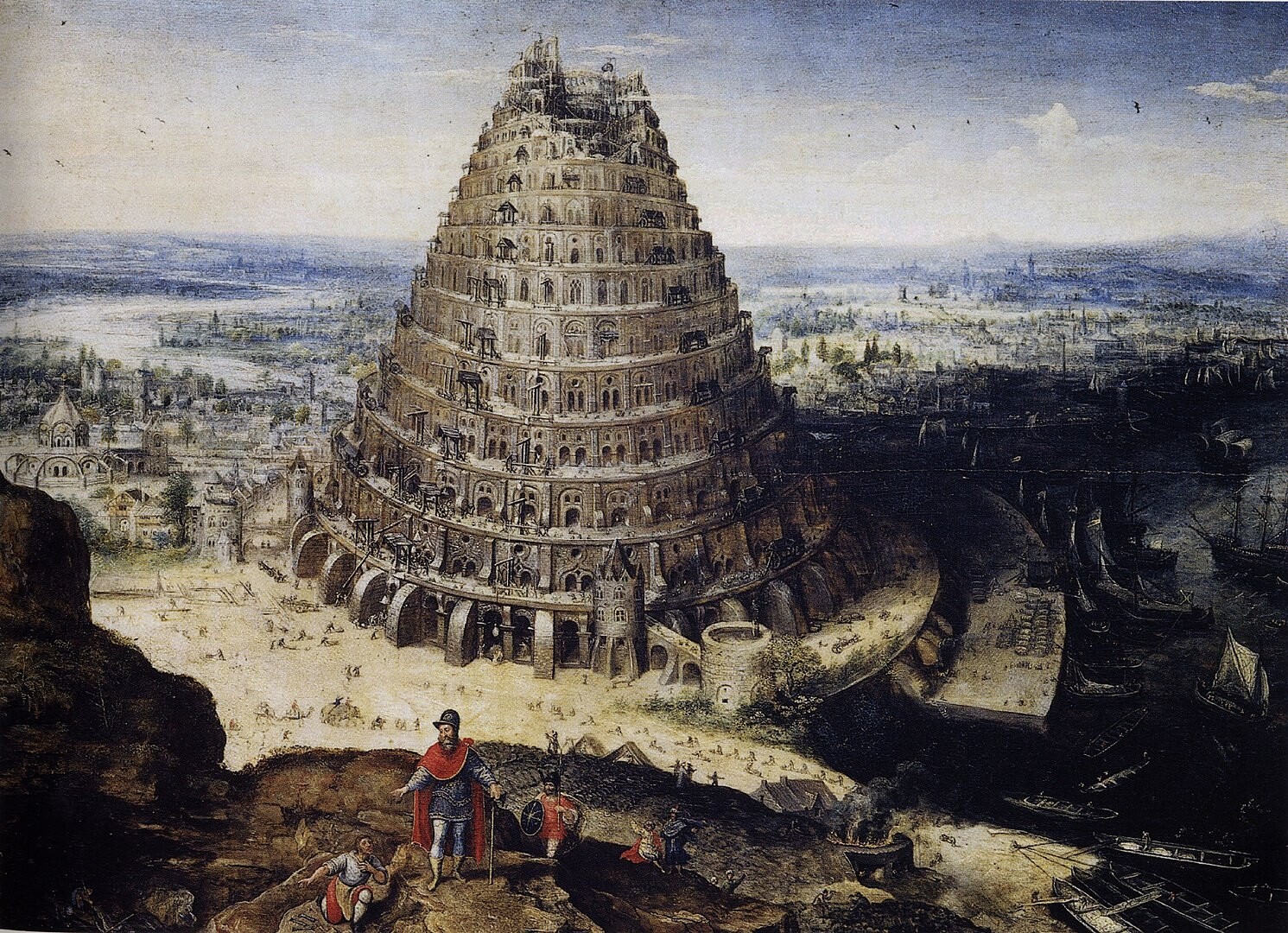Throughout most of written history, since the invention of writing by the Sumerian civilization, languages coexisted in relative harmony even when their speakers didn’t.1 Some thrived and others waned, yet there are no examples of systematic attempts (that we could find) to prohibit or extinguish a language during antiquity. It is mainly with the emergence of nation-states that some languages became designated as official while many others were discouraged, suppressed, or banned altogether. Such destructive policies towards languages and dialects seem to originate in Europe and are then spread globally during colonization, although one must keep in mind that the sheer volume of documentation centered on European history at the expense of all other civilizations often tends to produce an optical distortion. Linguists calculate that at the current speed, almost half of the world’s 7,151 languages will disappear before the end of this century. This timeline is an incomplete account of language politics in many parts of the world, starting roughly from the beginning of nation-states.
1367: The first English law in colonized Ireland that specifically banned the use of the Irish language is enacted as Article III of the Statute of Kilkenny. The Article makes it illegal for English colonists in Ireland to speak the Irish language and for the native Irish to speak their language when interacting with them.
1380: Under Olaf II of Denmark, Norwegian and Danish are used in education and administration in the Faroe Islands.
1482: The Valencia Bible, the first bible in the Catalan language, is burned.
1492: Gramática de la lengua castellana by Antonio de Nebrija is the first grammar book dealing with the Spanish language and the first grammar book of a modern European language to be published. The book is deemed “the companion of the Empire.” About his work, Nebrija notes in a letter to Isabella I, Queen of Castile: “After Your Highness has subjected barbarous peoples and nations of varied tongues, with conquest will come the need for them to accept the laws that the conqueror imposes on the conquered, and among them our language; with this work of mine, they will be able to learn it, as we now learn Latin from the Latin Grammar.”
1535: The Laws in Wales Act decrees that English is to be the only language used in Welsh courts and that Welsh speakers are barred from holding public office.
1536–1814: Danish gradually comes to dominate many sectors of Norwegian life, as an influx of Danish adminstrators there use their own language instead of Norwegian.
1537: The Statute of Ireland – An Act for the English Order Habit and Language prohibits the use of the Irish language in the Irish Parliament. In 1541, further legislation is passed banning the use of Irish in the areas of Ireland then under English rule.
1567: King Philip II of Spain makes the use of the Arabic language illegal.
1570: King Phillip II of Spain declares Nahuatl the official language of the colonies of New Spain, in order to facilitate communication between natives and Spanish colonists.
1633: Philip IV of Spain decrees that Roma people do not exist, effectively banning the Romani language and traditional culture.
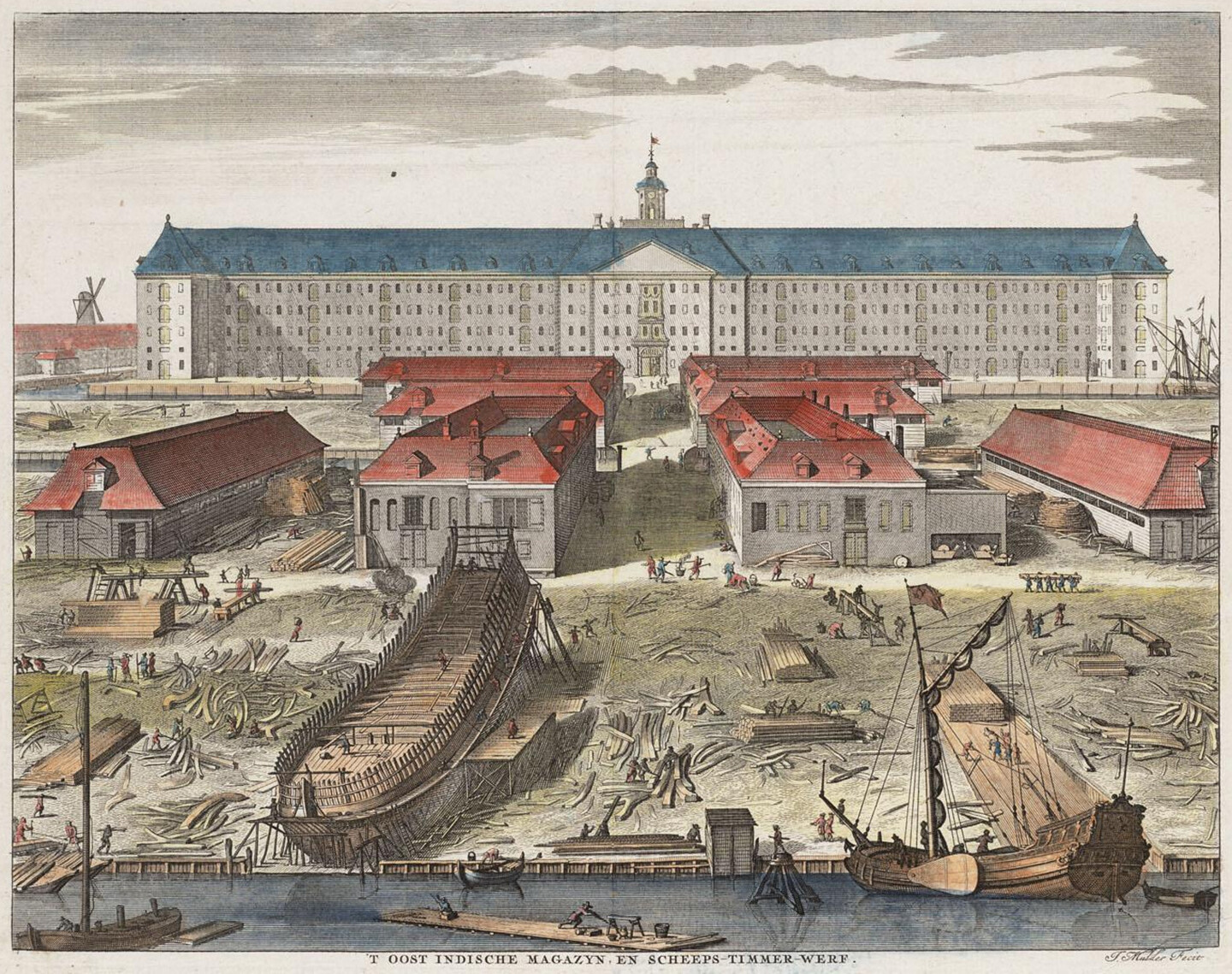

Shipbuilding yard of the Dutch East India Company. License: Public Domain
1652: The Dutch East India Company establishes a trading post in Cape Town. European colonizers (Afrikaners) moved to the Cape and gradually establish farms in the Dutch Cape Colony, which functions as a Dutch slave state.
1650–1707: Ehmedê Xanî, a Kurdish intellectual, is considered to be the founder of Kurdish nationalism. Xanî stressed the importance of the Kurdish language within the ongoing struggle against the Ottoman and Persian empires.
1697: Under Peter the Great in Russia, Belarusian loses its status as an official language and is banned from all court and state documents.
1707–1716: La Nueva Planta decrees signed by Philip V, the king of Spain, constitute the first attempt to centralize several territories under a single administration. Imposed by force, Castilian Spanish becomes the exclusive language of the government, administration, publications, commerce, education, and religion, banishing Andalucian, Aragonese, Catalan, Galician, and other languages of Spain.
1737: The Administration of Justice Act is passed by the Irish Parliament, forbidding the speaking of Irish within the courtroom and prohibiting the completion of legal documents in Irish. The Act imposes a financial penalty of £20 each time Irish is spoken in court.
1757: Joseph I, King of Portugal, bans the indigenous Tupinambá language in colonized Brazil.
1760–1764: The Savoy government replaced Sardinian with Italian in all sectors of public life. Prior to 1720, when Sardinia was ceded to the House of Savoy, the island was part of Spain, and Castilian, Catalan, and Sardinian languages enjoyed freedom in all domains.
1770: King Carlos III of Spain issues a decree that prohibits the use of Indigenous languages in all colonies of Spain.
1772: Following the First Partition of Poland, the lands that became part of the Prussian state under the reign of Frederick the Great are subjected to several measures of ethnic cleansing. The Polish language is replaced by German in administration
1775: The Marquis of Pombal, a Portuguese diplomat, prohibits the use of Indigenous languages in Brazil.
1782: The Rebellion of Túpac Amaru II, an uprising of native and mestizo peasants against the Spanish Viceroyalty of Peru, ends after two years of struggle. As a result of the uprising, Spanish colonial administrator José Antonio de Areche bans the Quechua language and most aspects of Inca culture.
1789: The French Revolution begins. At first, the revolutionaries declare liberty of language for all citizens of the Republic; this policy is subsequently abandoned in favor of the imposition of a common language that was to do away with the other languages of France.
1795/1806: Invasion of the Cape Colony by the British Empire as part of the fight for control over diamond and gold mines. Dutch farmers are forced to migrate towards the north, where they establish settlements in the interior of South Africa.
1810: Hawai’i becomes a unified kingdom.
1819: Prussian officials abolished Polish from courts and partially from schools, introducing educational programs in German.
1831: The first residential school opens in Canada. The school system, funded by Canada’s Department of Indian Affairs and administered by Christian churches, is designed to deprive Indigenous children of their native languages and cultures by forcing them to speak English and cut ties with their communities.
1837: In India, the British East India company forgoes Persian as the official language of government offices and the courts and replaces it with local vernaculars, primarily Hindi. In northern India, Urdu replaces Persian.
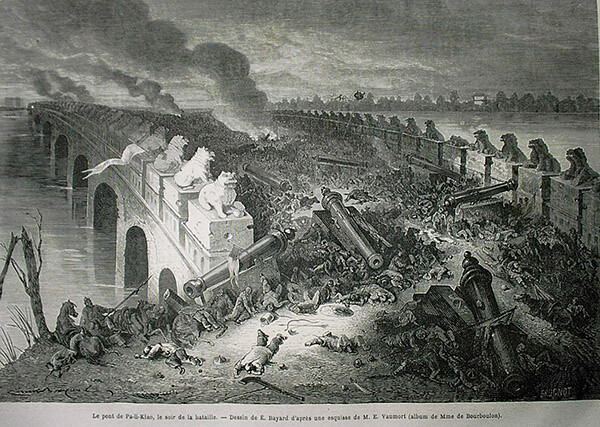

Pa-Li-Kiao’s bridge, on the evening of the Battle of Palikiao (Baliqiao), which took place on September 21, 1860 during the Second Opium War (1856–1860). The Anglo-French victory opened a path to Beijing for Western armies. License: Public Domain
1839–1842: The First Opium War between the Chinese Qing Dynasty and the British Empire. The conflict terminates through the Treaty of Nanjing, according to which the Qing Dynasty cedes Hong Kong to the British Empire. English becomes Hong Kong’s only official language of politics and administration.
1842: Teaching Romanian in Bessarabia is forbidden.
1848–1871: Unification of Italy.
1850s: In the second half of the nineteenth century, speakers of languages other than German are labeled as Reichsfeinde or “foes of the [Prussian] empire.”
––––By the 1850s, only about half of the population of Wales can speak Welsh, compared to almost 100 percent in the eighteenth century, partially due to the increased number of English-speaking migrants, but also because of the British government’s destructive policies aimed at eradicating the Welsh language.
1851: Norway passes a law forcing Sámi schools to teach in Norwegian.
1857: The September 19 issue of The Cape Argus, an English-language newspaper, describes Afrikaans as a “miserable, bastard jargon,” not worthy of being called a language, and advocates for the “atrocious vernacular” to be stamped out.
1860: Speakers of Occitan form over one third of the French population. By 1993, discriminatory French policy has reduced this proportion to less than 7 percent, and then less than 1 percent by 2012.
1864-1904: Books in the Lithuanian language are illegally published abroad and smuggled into Lithuania, where printing Lithuanian in Latin script is forbidden by the imperial Russian authorities. Lithuanian book smugglers are known as knygnešiai, or “book carriers.”
––––Belarusian, Polish, and Lithuanian are banned in public spaces in the Russian Empire.
1867: The Native Schools Act is established in New Zealand, creating a national system of primary schools, where instruction is to be conducted in English. The Act stipulates that it is the onus of Maōri communities to request a school, form a school committee, supply land for the school facilities, and pay for half of the building costs and a quarter of the teachers’ salaries.
1868: Ezo Island is annexed by Japan’s Meiji government and renamed Hokkaido. As Japanese settlers colonize the island, the native Ainu are forced to attend Japanese schools and their language is banned.
1873: German becomes the primary means of instruction in all Prussian schools in the Polish-speaking territories.
1879: Japan annexes Ryukyu and begins a policy of forced Japanization. Ryukyuan languages are suppressed, and children are punished for speaking their native tongues in school. Today, the Ryukyuan languages are severely endangered.
1880: The Second International Congress on Education of the Deaf is held in Milan. The conference declares that oral education is superior to manual education and passes a resolution to ban sign language in many European countries and the US. In 2010, at the 21st iteration of the Congress in Vancouver, the members issue a formal apology for the ban.
1880–1902: Under US rule, the number of schools in Hawai’i where Hawaiian is the language of instruction drops from around 150 to zero.
1880s: Polish schooling is banned in the Russian Empire.
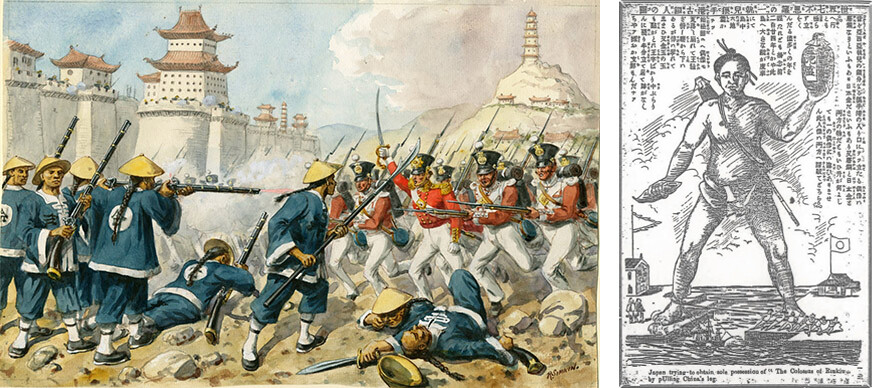

Left: The 98th Regiment of Foot at the attack on Chin-Kiang-Foo (Zhenjiang), 21 July 1842, resulting in the defeat of the Manchu government. Watercolour by military illustrator Richard Simkin (1840–1926). License: Public Domain
Right: Cartoon from Marumaru Chinbun, May 24, 1879, with the caption “Japan trying to obtain sole possession of the ‘Colossus of Riukiu’ by pulling China’s leg.” License: Public Domain
––––German East Africa, a colony spanning territories of present-day Burundi, Rwanda, and Tanzania, is founded. German colonists start the process of de-Arabization, relying on Swahili in administration and encouraging its spread by developing an educational program and creating teaching materials. The Swahili word for school, shule, is a borrowed word from German. Although German is taught at schools, Swahili is the medium of instruction. Today, Swahili is a predominant and official language in numerous East African countries.
1881: Under Alexander II, the Russian Empire becomes an immense multilingual state with over 150 linguistically distinct groups. The Tsars pursue a policy of ruthless assimilation of ethnic minorities: Alexander II prohibits the use of Ukrainian in all schools, theaters, and public performances until 1919, and Belarusian is prohibited until 1905.
––––Jules Ferry Laws in France. Educational reforms aimed at improving literacy rates in rural areas make free primary education compulsory. Any languages other than French are forbidden, even in schoolyards, and any transgression is severely punished.
1885: Mandatory use of Russian in Baltic governance.
1887: Esperanto, an international auxiliary language, is created by Warsaw-based ophthalmologist L. L. Zamenhof. It is intended to be a universal second language to improve communication between nation-states and prevent wars.
––––The United States of America Indian Affairs Commissioner bans Native languages in schools.
1890s: Russian becomes the language of instruction at all schools in the Baltic countries.
1892–1907: At tribal schools in Kurdistan, the teaching of Kurdish, “the barbarian language,” is forbidden. The sole medium of education is Turkish.
1893: United States troops invade the Hawaiian Kingdom without just cause, which leads to a conditional surrender by the Hawaiian Kingdom’s executive monarch, Her Majesty Queen Lili’uokalani.
1895: Taiwan becomes a dependency of Japan after Japan’s victory in the First Sino-Japanese War, and Japanese becomes the island’s official language. By 1941, nearly 60 percent of Taiwanese can speak Japanese.
1896: Teaching and learning in Hawaiian is banned by Act 57, Section 30 of the Laws of the Republic of Hawaiʻi. The use of Hawaiian is from now on restricted to the recitation of the Lord’s Prayer during chapel services.
1898: Norway and Sweden pass laws that completely forbid the use of Sámi in the education system.
1899: The Philippine-American War ends in victory for the United States. As a result, the US declares English to be the primary language of education, ending the centuries-long usage of Spanish. The change does not go into widespread effect until after WWI, when major Catholic universities phase out Spanish in favor of English.
1900: The Language Manifesto, a decree by Nicholas II, makes Russian the language of administration in Finland.
1901–1902: Wrześia children strike in response to the banning of the Polish language in schools. Pupils refuse to participate in class activities, for which they are punished with detention or beaten up. Their parents are arrested by the Prussian police, and the strikes are eventually suppressed.
1905–1970: Australian government agencies carry out a campaign of forced removal of Australian Aboriginal and Torres Strait Islander children, now known as the Stolen Children, relocating them to church missions where they are punished for speaking their native languages. In some regions, it is estimated that one in three Indigenous Australian children was forcibly removed in this manner.
1908: The Kurdish Society for Cooperation and Progress is the first political Kurdish organization to advocate for a political, social, and economic awakening of Kurdistan. They issue newspapers and publications that highlight the importance of developing the Kurdish language. The organization does not, however, support the idea of an independent Kurdistan.
1910: The Union of South Africa is created as a self-governing dominion of the British Empire. Only Dutch and English become the official languages of the new country.
––––Japan bans Korean and forces Koreans to adopt Japanese names.


Japanese marines landing from the warship Unyo at Yeongjong Island, which is near Ganghwa. woodcut print, 1876. License: Public Domain
1913: The Commission on the Unification of Pronunciation is established by the new government of China, with an aim to create national standards for written and spoken language use. During the talks, there is great disagreement between the delegates as to which variant of Chinese should be chosen as the basis for the new standard. Eventually, the northern dialect of Mandarin Chinese becomes the language of the Republic, though several others, including Manchu, Mongolian, Tibetan, and Uyghur, are recognized as national languages.
1914: World War I begins.
1917: Declaration of Rights of the People of Russia. Lenin believes in absolute freedom and equality of nations and languages and in self-determinism. He aims to reinvent post-tsarist Russia as a multilingual state.
––––In the United States, the Trading with the Enemy Act (50 USC Appendix) passes in June, suppressing the American foreign-language press and declaring non-English printed matter unmailable without a certified English translation.
––––As the United States enters WWI, German is banned in a number of states.
1918: The world’s first Kurdish newspaper is published in Cairo and distributed for free. Due to the language ban in the Ottoman Empire, the newspaper has to be illegally smuggled in.
––––The use of German in Alsace-Lorraine is forbidden.
––––The Armistice of Villa Guisti ends warfare between Italy and Austria-Hungary. The region’s transferal to Italy marks the beginning of the linguistic genocide of the Slavic-speaking population.
––––During the Weimar Republic, ethnic minorities receive protection, and the previously employed methods of severe linguistic discrimination come to a temporary end.
––––Lithuania, Latvia, and Estonia gain independence, and the majority-spoken languages become the official state languages of the newly independent states.
––––In an effort to standardize the language, Estonia implements policies that exclude the use of South Estonian in education. South Estonian is diachronically a separate branch of Finnic language from North Estonian, which serves as the basis for modern standard Estonian.
1919: The Dictionary of National Pronunciation is published in China.
1920s: At the end of WWI, the British take control of Tanganyika, the mainland part of Tanzania, and English becomes the official language of the country. Swahili is accepted only in administrations at the provincial or district level. The use of Swahili as a language of instruction in education becomes limited to the first five years of primary school. English is introduced as a subject in the third grade and replaces Swahili as a medium of instruction in secondary school and in higher education. Swahili is available only as a subject.
––––Nativization/Indigenization in the USSR. The writing system of several languages is changed to Cyrillic in an attempt to “unify” the languages. Only languages with long-standing literatures, such as Georgian and Armenian, escape this trend. The Romanization/Latinization of Arabic script affects, among other languages, Azeri, Kazakh, Turkmen, and Uzbek. The USSR operates on a hierarchy of four types of languages:
A. Small languages without scripts of the tiny and territorially scattered ethnic groups: mostly in Siberia. Education and literature should be created in Russian.
B. Small to medium-sized languages without their own scripts of territorially ununited agricultural peoples. Political propaganda, literature, and primary schools in native languages; secondary education in Russian.
C. Medium-sized to large groups using traditional scripts. Everything in native language. Russian shall be introduced no later than the third grade.
D. Bigger languages with their own literatures, typically coinciding with more economically developed nationalities: Ukrainian, Lithuanian, Latvian, Azeri, Georgian, Uzbek, etc. Russian shall be introduced no later than the third grade.
––––Gradual territorial dismemberment of the Ottoman Empire, culminating in the Treaty of Sèvres, according to which Kurds are to be given local autonomy with the right to appeal for independence to the League of Nations within a year. The treaty, however, is never ratified and is later replaced by the Treaty of Lausanne, which considers arguing for separation of any part of Turkey to be a crime.
––––Following the treaty and annexation of the Austrian Littoral (later Julian March) by Italy, the new government starts a harsh process of Italianization of the region: three political parties are banned; around seven hundred Slavic-language institutions are closed (youth and sport clubs, social and cultural institutions, libraries, businesses, banks and other financial institutions, etc.); thirty-one newspapers and journals are forbidden. Also, 488 Slovene and Croatian primary schools are closed.
1921: Members of the Omoto religion in Japan adopt Esperanto as their official language.
––––The rise of Reza Shah Pahlavi in Iran, who believes in the “one nation, one language” policy. Persian (Farsi) is chosen as the only official language, and the use of Turkish is banned. Students who speak Turkish in schools are fined.
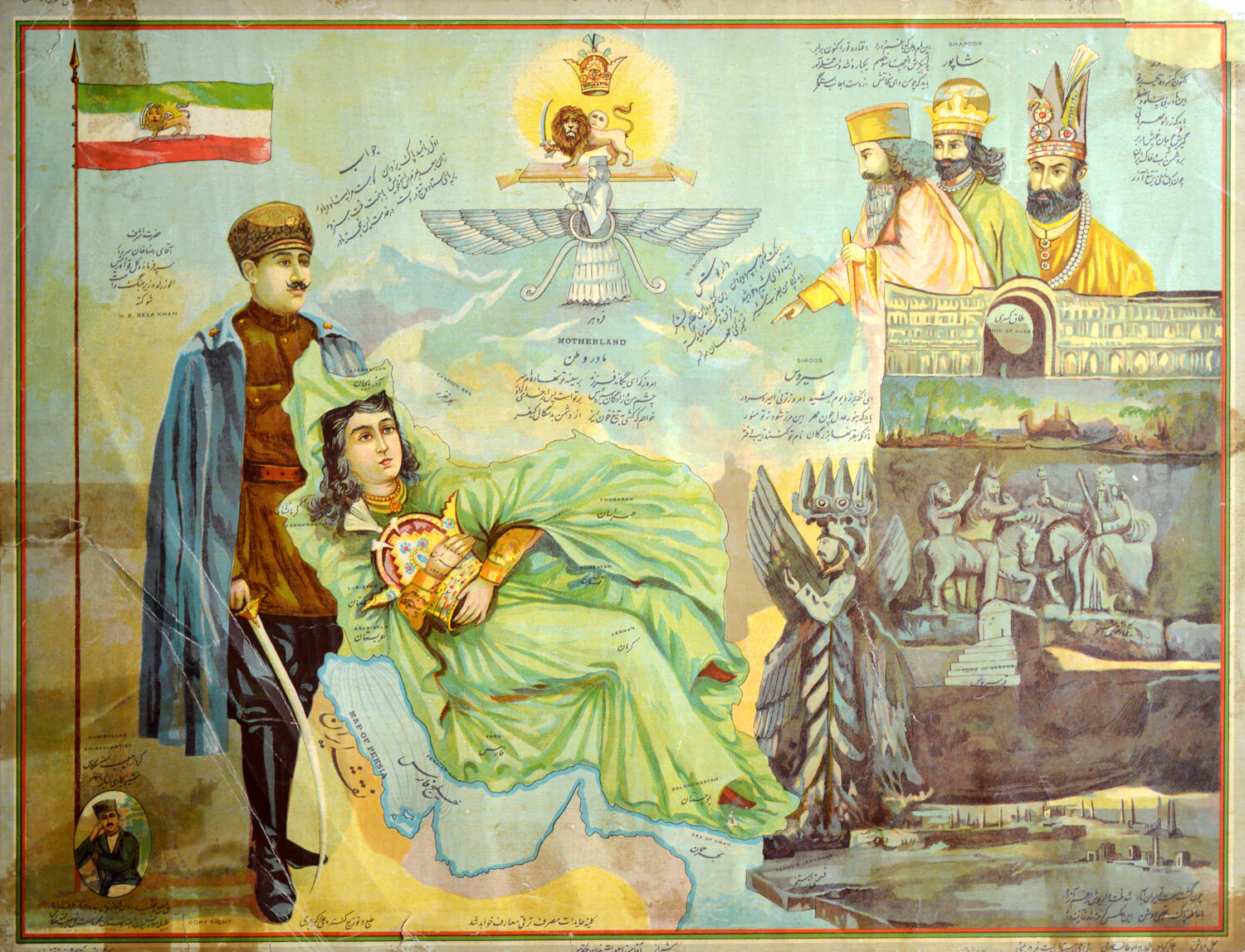

Reza Shah Pahlavi (1878–1944) and three emperors of ancient Iran: Daryush, Shahpur I, and Siroos (Cyrus). Aqa Mirza Habibullah Khan, Shiraz, Iran, circa 1920.
––––New York state institutes English literacy tests for voters.
––––The state of Louisiana bans the use of Cajun French from its school systems.
1922: The end of the Ottoman Empire.
1922–1943: Italy under fascist rule led by Prime Minister Benito Mussolini. During his dictatorship, oppressive means are employed to eradicate all other languages but Italian. Numerous war crimes are committed by Italian fascists to transform German- or Slavic-speaking regions into ethnic Italian territories.
1923: Croatian and Slovene are banned from administration in fascist Italy.
1924: Turkish Constitution: Article 12 states that citizens who do not speak and read Turkish cannot become members of parliament.
––––Lenin dies.
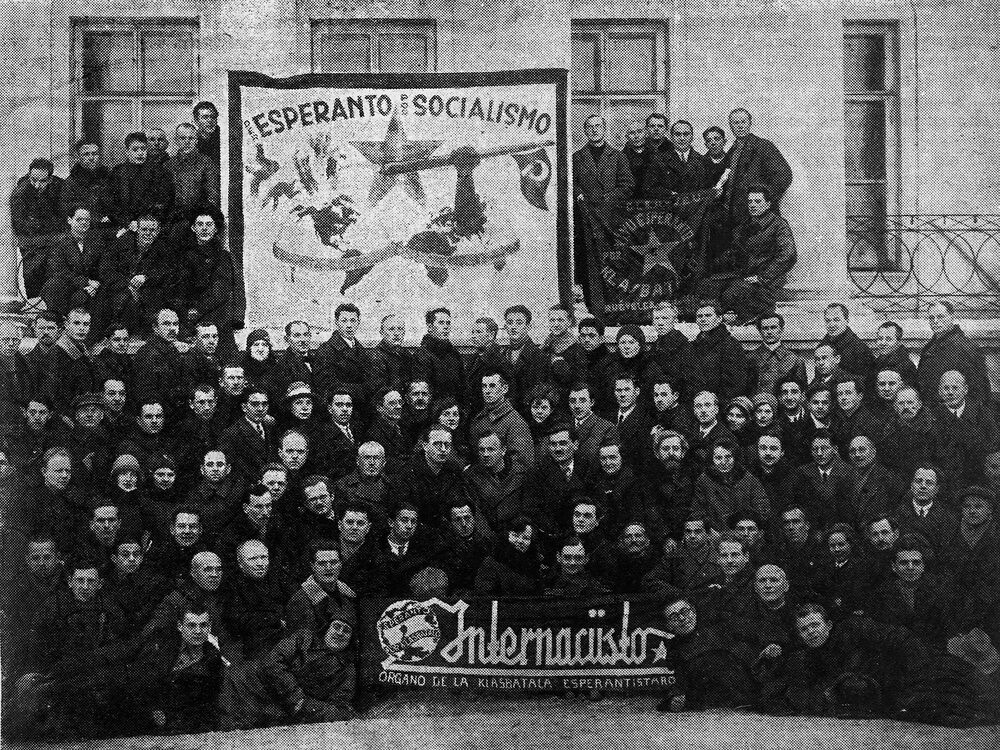
A meeting of the Soviet Republics’ Esperanto Union, held in Moscow in 1931. License: Public Domain
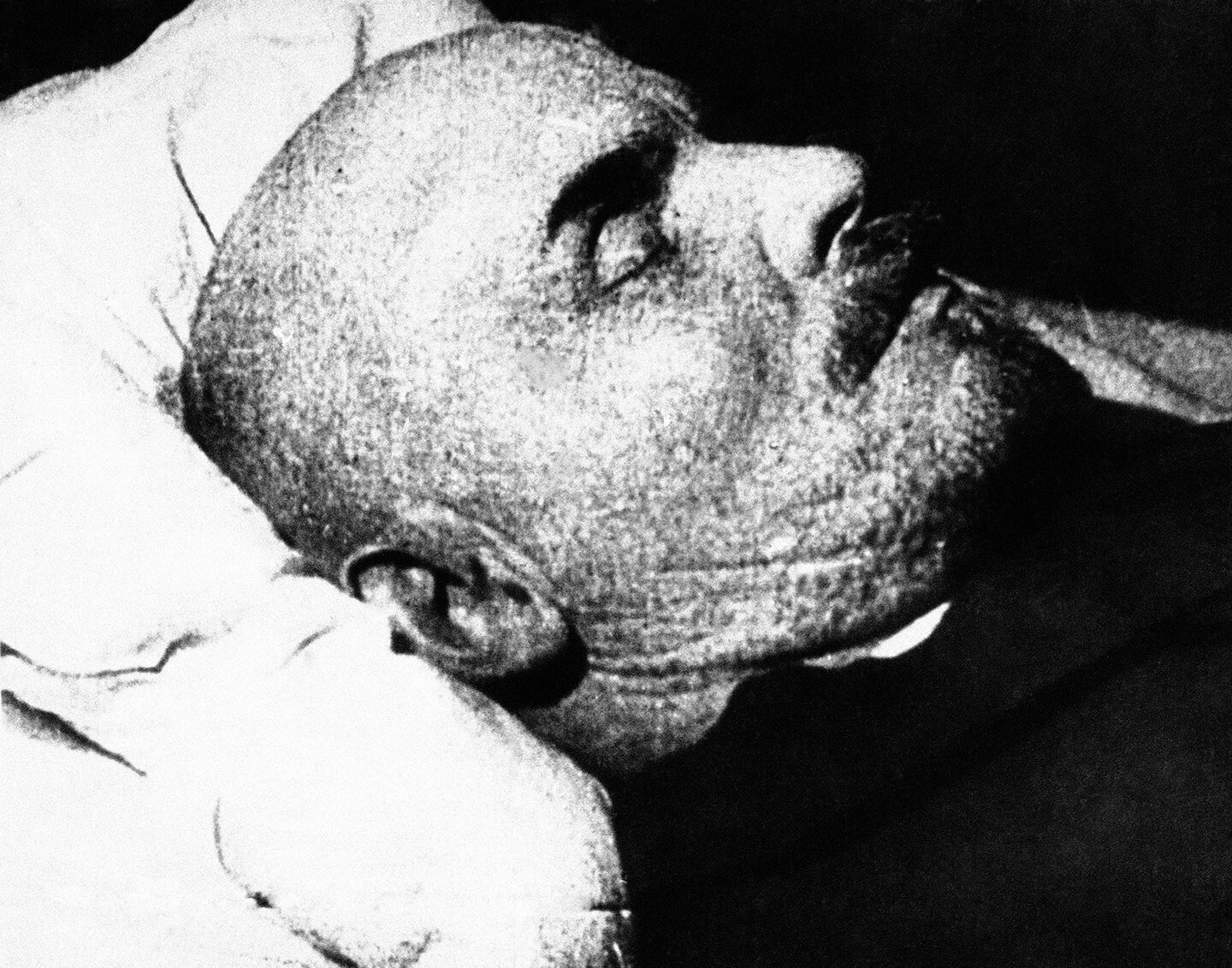
Vladimir Ilyich Lenin on his death bed
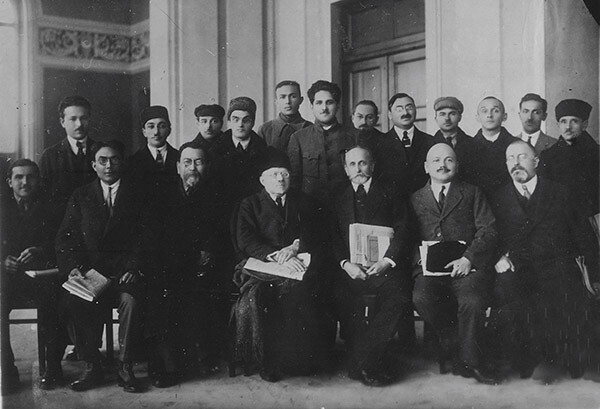
Participants of the First Turkologic Congress, 1926. License: Public Domain
A meeting of the Soviet Republics’ Esperanto Union, held in Moscow in 1931. License: Public Domain
––––Belarusian is banned from use in the upper echelons of government and education. Belarusian history is revised to create a single Belarusian-Russian narrative. No more publishing, theater, movies, lectures, choirs, etc. in Belarusian.
––––In the United States, the Immigration Act of 1924 slows immigration from the non-anglophone countries of Europe to a trickle and denies admission to anyone from just about everywhere else (Asians are banned completely, and, in the debate over the bill, Jews are singled out as particularly unassimilable).
1925: The Dutch language is replaced by Afrikaans as the official language of South Africa.
––––The Committee on Unification of the National Language in China decides to adopt the Beijing variant of Mandarin as the new national language.
––––French politician and scholar Anatole de Monzie, as minister of public education, states that “for the linguistic unity of France, the Breton language must disappear.”
1926: The First All Union Turkological Congress held in Baku mandates the Latin alphabet for all Turkic languages.
––––Italianization of German, Slovene, and Croatian names. Claiming that they would be returned to their original form, foreign first names and surnames are amended to sound Italian. After World War II, many of the oppressive laws are lifted, and the ideology of forced Italianization is abandoned. South Tyrol is granted autonomy within Italy on the grounds of its peculiar linguistic situation.
1927: The Communist Party of the Soviet Union recognizes the danger of “petty bourgeois nationalism.” Widespread regional languages with their own literatures are perceived by Stalin as dangerous and capable of their own nationalisms that need to be repressed so as not to pose a real threat.
1928: The Latin alphabet is adopted for writing Turkish in place of Arabic script. The goal is to further undermine the influence of religious leaders and break ties with the Ottoman past. The expected increase in literacy is supposed to aid in the spread of the concept of the nation.
––––In Germany, the Minorities School Act allows children to receive education in their native tongue.
1929: Decree of the Central Executive Committee of the Communist Party of USSR: the use of Arabic script is prohibited and its proponents are seen as class enemies. All publishing houses are ordered to cease printing in Arabic
1930s: In Tanzania, the Language Committee is founded to standardize and promote the development of Swahili.
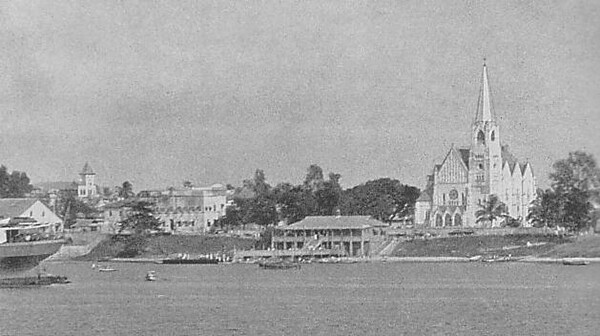

Tanzania, Dar es Salaam, 1930s, with the Old Boma and St. Joseph’s Cathedral prominently in view. License: Public Domain
––––In the USSR, Azerbaijani, Kalmyk, and smaller languages of Siberia shift to Latin-based scripts, though they return to Cyrillic by the late 1930s.
––––The Sun Language Theory is developed as a pseudoscientific nationalist theory, according to which all human languages originate from Turkish. The theory claims that Sumerians were Turks who originated in Central Asia and developed language as a response to being awe-struck by the sun. The sun, as a deity, was the first thing to which a name was given, and all words were derived from this spark of language creation. This conception of Turkish history gains some following and is taught in some schools.
1932: Statute of Autonomy of Catalonia. Approved by 99 percent of voters, the Statute is the first to implement autonomy for Catalonia and make the Catalan language the co-official language of Catalonia, along with Spanish.
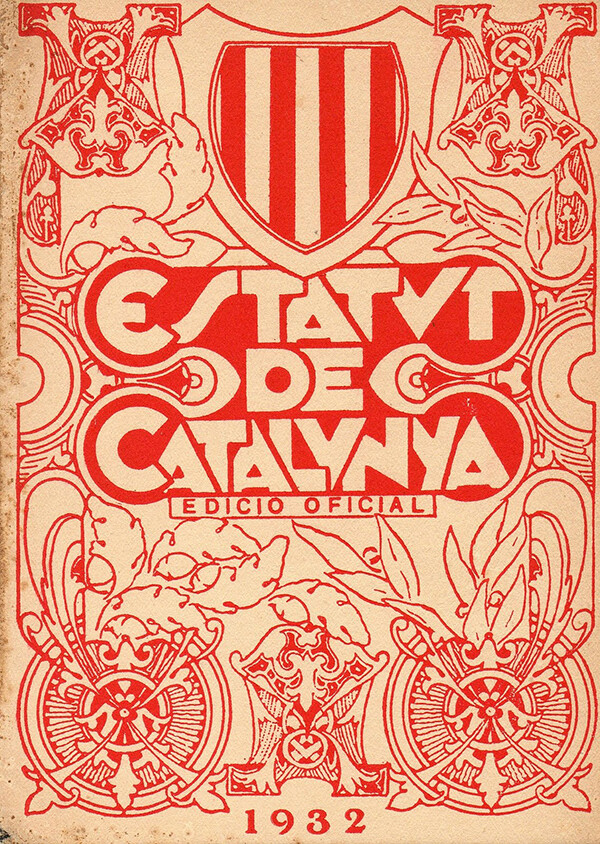

Front cover of the first Statute of Autonomy of Catalonia, 1932. License: Public Domain
––––Under the military dictatorship of Prime Minister Plaek Phibunsongkhram, Thailand enacts the Primary Education Act, which makes Thai the compulsory language of instruction. Following ongoing protests by Thai Chinese, in 1939, the government allows students to learn in Mandarin for a maximum of two hours per week.
1933–1945: Nazi Germany under Adolf Hitler.
1934: The XVII Communist Party Congress in USSR mandates the end of the nativization campaign and a shift from Latin to Cyrillic scripts. This also marks the start of a deliberate Russification policy.
––––The Constitutional Convention in the Philippines sets 1940 as the date by which Spanish will cease to be the official language of the legislature and courts.
1936: Stalin’s constitution. According to Stalin, the USSR is made up of approximately sixty nations, nationalities, and ethnic groups (during Lenin’s time this number was 180). Of seventy-one different alphabets previously in use, only eight were not “unified.” Unification of alphabets was seen as an integral measure toward developing the international language of the proletariat. A proposal is advanced to write Russian in the Latin alphabet, but the peak of the movement has already passed, and the proposal gains little support.
––––Following the example of Catalonia, the Basque Country and Galicia implement the Statute of Autonomy of the Basque Country and Statute of Autonomy of Galicia, granting the Basque and Galician languages, respectively, co-official status together with Spanish.
––––The Spanish Civil War begins.


Women soldiers, fighting on behalf of the Republic in the Spanish Civil War, 1936. License: Public Domain
––––Italian becomes compulsory in schooling and public life on the Dodecanese islands, which are ruled by Italy between 1912 and 1945. Greek becomes an optional subject at schools.
1938: Compulsory teaching of Russian is decreed by the Central Committee of the Communist Party for all students of all nationalities in the USSR.
––––The Mingrelian language is abandoned in favor of Georgian.
1939: World War II starts.
––––Military dictator Francisco Franco comes to power in Spain. During his regime, use of other languages in Spain, such as Catalan and Basque, is banned outside of the home, prosecuted, discouraged, or frowned upon. Castilian is declared the sole official language of Spain.
––––The Yiddish newspaper Der emes (The Truth), which was published in Moscow, is closed. Only seven Yiddish newspapers are left, compared to an estimated 170 periodicals in 1917.
––––Sōshi-kaimei is a policy of pressuring Koreans under Japanese rule to adopt Japanese names.
1940s: Cyrillic script is used for almost all languages in the Soviet Union. A handful of exceptions: Armenian and Georgian have their own scripts; Karelian retains Latin script; Yiddish uses a modified Hebrew script; Estonian, Latvian, and Lithuanian (occupied and annexed to the Soviet Union in 1940) use Latin script.
––––More than one million people of all ages in Brittany speak Breton as their main language. Today, there are around two hundred thousand speakers of Breton left, most of whom are elderly.
1941: Ionian islands (Corfu, Cephalonia, Zakynthos, Lefkada, and some minor islands) are annexed by Italy, leading to the installation of a fascist government led by Piero Parini. Italian immediately becomes the only official language, and Greek is made illegal in almost all spheres of life.
––––Germany invades the Kingdom of Yugoslavia. Despite the fact that the Yugoslavians are seen as racially salvageable by the Nazis, Hitler encourages his followers to “make this land German again.” In an attempt to do so, the use of Slovene is prohibited in public; the names of places are changed; all culturally important Slovene institutions are closed and associations dissolved; intellectuals, professors, and linguists are exterminated.
––––The Oromo language is banned from political life and schools under the dictatorship of Haile Selassie in Ethiopia. The Amharic language is forced upon the Oromo people.
1942: Alsace-Lorraine, formerly a French territory where German was banned, is annexed by the Germans. Speaking French is prohibited under the Nazi occupation. German becomes the official language and is an obligatory subject at schools.
––––The Japanese take over control of Indonesia from the Dutch and mount a campaign to ban all Dutch influence, including the Dutch language. The Japanese encourage the use of Malay, in an effort to win support from Indonesians.
1943: The Japanese government phases out all Korean language courses in occupied Korea. Teaching and speaking of Korean is prohibited.
1944: The Abkhaz language is forbidden at schools in favor of Georgian. All Abkhaz cultural institutions are forbidden.
––––Estonia, Latvia, and Lithuania are reoccupied by the Soviet Union. Russian becomes an official language, alongside Estonian, Latvian, and Lithuanian, respectively.
1945: The Republic of China establishes rule over Taiwan and forbids the use of Japanese in newspapers and schools. Officials promote Standard Mandarin by penalizing primary schools teaching in local languages and by banning local languages in mass media.
1946: With the occupation of Azerbaijan by the Iranian Army, teaching Azerbaijani is banned, and educational books printed by the national government are burned.
1948: India’s Uttar Pradesh, known as United Provinces until 1950, issues a regulation that children should be taught exclusively in Hindi, effectively banning Urdu as a language of instruction until it could be studied as an optional subject beginning in the sixth grade.
––––The government of Pakistan declares Urdu and English to be the only national languages of Pakistan, despite a majority of East Pakistan speaking Bengali and West Pakistan speaking Punjabi as their mother tongues.
––––The National Party of South Africa wins elections with the slogan “our own people, our own language, our own land.”
––––Under the colonization of Palestine, Israel embarks on a campaign of Hebraization of Palestinian place names.
––––With the Home Rule Act of the Faroe Islands, Faroese regains its status as the national language over Danish.
1949: In the Soviet Union, all Jewish schools are abolished, and all Jewish cultural institutions are closed.
––––Under the Law on Provincial Administration, Kurdish names of places are changed into Turkish.
––––The People’s Republic of China is declared.
1949: The government of India approves a resolution deemed the “forty-ten plan,” which states that primary schooling must be conducted in the mother tongue of the child and that arrangements should be made to facilitate this in areas where the mother tongue differs from the official state language. These arrangements entail appointing one teacher to instruct in the mother tongue, provided there are at least forty students speaking the language within the whole school, or at least ten students in a class. The implementation of this rule significantly stalls in regions with Urdu-speaking majorities. In Uttar Pradesh, education officials explicitly refute the resolution and issue an order that bans instruction in Urdu in primary schools controlled by municipal and district boards.
1950s: Attempts to establish Russian as the official language of the Soviet Union.
––––During the Fourth Republic in France, the policies regarding minority and regional languages are relaxed slightly. Speaking languages other than French at primary schools is no longer forbidden, and the teaching of regional languages in secondary schools is allowed.
1950s–1980s: The Chinese government declares most languages other than Mandarin as mere dialects.
1952: After the government of Pakistan outlaws public rallies in order to quell demand for Bengali to be added as an official language in addition to Urdu, University of Dhaka students organize a series of public protests. On February 21, Pakistani police open fire on protestors, killing five students and injuring hundreds. Since 1999, the day is now recognized by UNESCO as International Mother Language Day.
1954: The Tanganyika African National Union (TANU) is formed. TANU uses Swahili as its official language. Members of TANU attempt to mobilize the population in the struggle for independence.
1956: Mandarin becomes the only national language of China. It is based on Beijing pronunciation and standardized báihuà grammar. Mandarin is made the mandatory medium of education for schools throughout China apart from “autonomous” areas. The government spreads posters with slogans such as “love the national flag, sing the national anthem, and speak Mandarin.’
––––Pakistan grants official status to Bengali.
1958–59: Education Reforms under Khrushchev begin an open shift toward Russification of the USSR. Education in one’s mother tongue is no longer compulsory, and Russian-language instruction comes at the expense of smaller native languages, which are relegated to study as a secondary subject.
1959: As the Communist Party of China puts further restrictions on Tibetan language, religion, and culture, unrest in Tibet grows, and the Dalai Lama is forced to flee from Tibet to India.
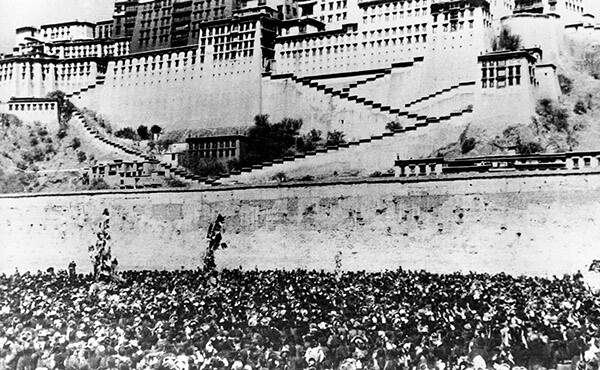

Tibetan uprising, 1959. License: Public Domain
––––Russian becomes the main language of the Soviet Union, occupying a central position in education, administration, and government.
––––Hawai’i becomes the fiftieth state of the United States. The government funds a Committee for the Preservation of Hawaiian Language, Art, and Culture at the University of Hawai’i.
1961: After clashes with the Indian armed forces, Goa, a province on India’s western coast, is freed from nearly four hundred years of Portuguese control. Portuguese ceases to be the official language, though it is still used in newspapers and in legislation, alongside English, until 1972 and 1969, respectively, when it is replaced by Marathi and Kōṅkaṇī.
––––In Hawai’i, schools start offering elective courses in the Hawaiian language.
1964: The United Republic of Tanzania gains independence. It consists of Tanganyika, or mainland Tanzania, and the Zanzibar Archipelago. Swahili becomes the national language of Tanzania.
––––For the first time, one and a half minutes of Breton are heard on regional television.
1966–1976: The Cultural Revolution in China under Mao Zedong continues the promotion of Standard Mandarin. The government denies the use of local languages in schools. All minority languages are suppressed at schools, and those who raise questions about the curriculum are denounced as supporters of capitalism and enemies of the state. During this time, literacy rates fall for every minority region. Numerous crimes against ethnic minorities are carried out: language schools in ethnic Korean areas are destroyed; countless books of the Uyghur people are burned; of almost 790,000 persecuted people in Inner Mongolia, 22,900 are beaten to death and 120,000 maimed; over six thousand Tibetan monasteries are destroyed.
1966–1998: Military dictator Suharto bans the Chinese language in Indonesia.
1967: The Soviet press is tightly controlled by the government, which carries out censorship of published content. The three major newspapers are published in Russian.
––––Prohibition of the distribution of foreign material in the Kurdish language in Turkey.
––––Presidential Instruction No. 14/1967 on Chinese Religion, Beliefs, and Traditions effectively bans any Chinese literature and culture in Indonesia. This includes the prohibition of Chinese characters.
––––The Welsh Language Act passes in the UK. It enables the use of Welsh in Welsh court proceedings.
1968: Joan Manuel Serrat is banned from participating in the Eurovision Song Contest because of his wish to sing in Catalan.
1969: The state of Haryana in India makes Tamil the state’s second official language, alongside Hindi, despite there being no Tamil speakers in the state. The ruling was politically motivated in order to demonstrate the state’s differences from Punjab, despite Punjabi being one of the most spoken languages within the state.
1970s: Lithuanian can no longer be used in official documents. Despite the fact that most of the Central Committee members are Lithuanians, all meetings are to be held in Russian.
––––Nationalist movements in regions such as Brittany, Corsica, and Occitania emerge. These lead to the opening of schools—Diwan in Brittany, Ikastola in the Basque Country, Calandreta in Occitania, and La Bressola in Northern Catalonia—where regional languages are taught.
1971: Bengali nationalism culminates in the Bangladesh War of Independence, in which Bangladeshi guerilla forces are aided by India. Once independence from Pakistan is won, Bengali is declared the official national language.
1972: Members of the Legislative Council of Hong Kong are permitted to use Cantonese for the first time.
––––Georges Pompidou, the president of France at the time, states that “there is no place for minority languages in a France destined to make its mark on Europe.”
––––Sindh province in Pakistan passes the Sindhi Language Bill, which establishes Sindhi as the sole official language. After protests by Urdu-speaking residents, Pakistani Prime Minister Zulfikar Ali Bhutto compromises and announces both languages to be official.
1974: The Official Chinese Language Ordinance is enacted in Hong Kong: Chinese becomes a “co-official” language alongside English. The Ordinance mandates that all laws are to be published in both English and Chinese, and the use of Chinese becomes legal in courts. However, it does not specify the variety of Chinese to be used.
1975: Doctoral dissertations in Lithuanian are no longer permitted.
––––After Indonesia annexes East Timor, authorities ban Portuguese and impose Indonesian. Portugal had controlled East Timor since wresting control from the Netherlands in 1859.
––––The Republic of China government in Taiwan adopts the Radio and Television Act, which restricts the use of local languages on radio or television.
––––The Liberation of Saigon in Vietnam. The new Vietnamese government establishes Vietnamese as the only official language in the country, ending the supremacy of the French language, which had been in place since the 1890s.
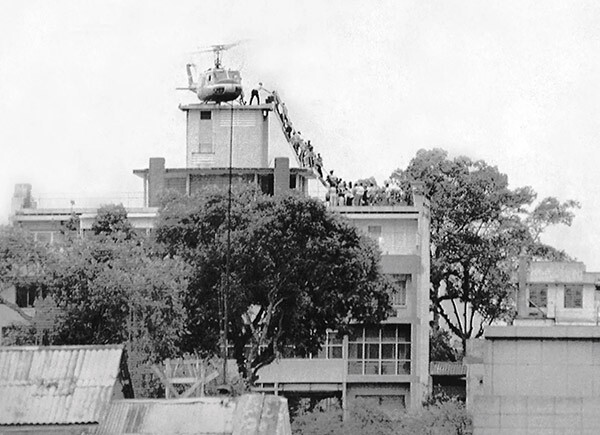

Air America helicopter evacuating Vietnamese officials and their families from the roof of an apartment building at 22 Gia Long Street in Saigon, South Vietnam, April 29, 1975. Photo: Hubert Van Es—UPI/Newscom
––––Peru becomes the first country to recognize Quechua as one of its official languages, with Ecuador following in 2006 and Bolivia in 2009.
1976: In Georgia, doctoral dissertations should be published and defended in Russian.
––––The Afrikaans Medium Decree bans languages other than Afrikaans and English as the medium of instruction in all Black schools from the last year of primary school. While English is associated with the colonial past, Afrikaans is seen as the language of the oppressive white government, the language of apartheid.
––––“To hell with Afrikaans” becomes one of the central slogans of the Soweto uprising.
1978: In the Baltic states, instruction in Russian is mandated from preschool to university. Russian spreads to the level of local administration in accordance with Brezhnev’s goal of fusing nationalities into a supra-nationality.
––––Abdullah Öcalan founds the Kurdistan Workers’ Party (PKK).
––––The new democratic constitution of Spain recognizes linguistic plurality.
1979: The Education and Training Act in South Africa: racially segregated schooling continues, but the use of native tongues is allowed until the fourth grade. In later education, pupils may choose between English and Afrikaans; the majority prefer English as a means of not learning Afrikaans.
––––The Constitution of the Islamic Republic of Iran recognizes only Persian (Farsi) as the official language.
1980: Military coup in Turkey. The suppression of the Kurds intensifies. The Kurdish population is targeted by new laws forbidding speaking or publishing in Kurdish.
1981: Brezhnev proclaims the triumph of the creation of a united Soviet people. Until 1989, language policies remain unchanged. Afterwards, laws in Union countries are passed to strengthen non-Russian languages.
1983: Law no. 2932 concerning Publications and Broadcasts in Languages other than Turkish is enacted and remains in force until 1991. The law strictly prohibits the use of the Kurdish language and results in numerous prison sentences throughout the 1980s. The names of Kurdish villages that had not been previously changed in the 1960s are adjusted into Turkish. Kurdish families are forced to give Turkish names to their children. This repression results in the survival of the PKK as the only organization supporting the Kurdish people in Turkey.
1986: Hawaiian is allowed to be used as the language of instruction in public schools.
1987: Spanish loses its official language status in the Philippines after the ratification of a revised Philippine Constitution that lists the official languages as Filipino and English.
––––Maōri becomes an official language of New Zealand.
1989: A Syrian decree prohibits the use of Kurdish in workplaces and in wedding ceremonies.
1990s to present: In many post-Soviet countries, a systematic process of de-Russification occurs following the breakup of the Soviet Union. The number of Russian speakers decreases tremendously, as many Russians migrate to newly independent states. Many languages that previously used Cyrillic script—Azerbaijani, Moldavian, Turkmen, and Uzbek—switch to Latin-based alphabets.
1991: Turgut Özal lifts the ban on speaking Kurdish in private.
––––Adoption of a Latin-based script, instead of Cyrillic, for writing in Turkmen.
––––Lithuania, Latvia, and Estonia gain independence, and the majority-spoken languages become the official state languages of the newly independent states.
––––Ethiopia’s Derg regime is overthrown and the ban on the Oromo language is overturned.
1992: Dissolution of the Soviet Union.
––––The French Constitution is amended to explicitly state that “the language of the Republic is French.”
––––Syria prohibits parents from using Kurdish names when registering children.
––––Paraguay establishes itself as a democracy and ratifies a new constitution that establishes Guaraní as on the same legal level as Spanish.
1993: The Welsh Language Act makes the Welsh language equal to English.
1994: Sixty-three languages in Russia are considered to be endangered as a result of Russification.
––––Apartheid in South Africa ends, with Nelson Mandela as the first Black president.
––––The Toubon Law mandates the use of French in official publications by the government, in advertisements, in all product packages, and at the workplace and government-funded schools. The law makes many schools that teach in local languages ineligible for funding.
1996: The New Constitution of South Africa recognizes eleven official languages of the Republic: Afrikaans, English, Ndebele, Sepedi, Sesotho, Setswana, Swazi, Tshivenda, Xitsonga, Xhosa, and Zulu. The Constitution also recognizes the historically neglected and thus diminished indigenous languages.
––––The Guatemalan Civil War ends and Guatemala formally recognizes twenty-one Mayan languages. The Civil War, begun in 1960, was fought between leftist rebel groups and the Guatemalan government, which had been led by a series of US-backed military dictators. The government forces are condemned for widespread human rights violations against civilians, including mass genocide of Maya populations, throughout the Civil War.
1997: The UK returns Hong Kong to China.
––––The last residential school closes in Canada. Between 1831 and 1997, it is estimated that around 150,000 Indigenous children were forcibly subjected to the residential schooling system, which aimed to assimilate them into Canadian society by displacing them from their languages and communities.
1998: An annual Mandarin Proficiency Test is conducted in China. A passing grade is necessary in order to obtain qualified jobs.
––––The state of California adopts Proposition 227, which bans bilingual education. It is repealed in 2016.
1999: Abdullah Öcalan is captured in Kenya by the Turkish military.
––––Turkey is officially recognized as a candidate for joining the EU, but on the condition that the government changes its language policy regarding national minorities to allow for broadcasting and schooling in their mother tongues.
––––A report written for the French government by French linguist Bernard Cerquiglini identifies twenty-four languages indigenous to the European territory occupied by France that would qualify for recognition under the government’s proposed ratification of the European Charter for Regional or Minority Languages. The Charter has still not been ratified by France.
––––In Italy, twelve historical minority groups and their languages are recognized as such by the national law.
––––Thailand enacts the National Education Act, which grants twelve years of free education in the Thai language. One-third of teens in Thailand are still considered functionally illiterate as a result of a monolingual education system that disregards majority Malay-speaking communities. The Thai government has historically treated other minority languages as mere dialects of Thai, in an effort to strengthen Thai national identity.
2000: TV Breizh, a private TV channel, is launched in Brittany. The initial goal is to provide a wide range of programs in Breton, but their number gradually decreases in favor of French-language broadcasting, until they disappear completely by 2010.
2002: President Niyazov of Turkmenistan prohibits the National Library of Turkmenistan’s access to Russian-language publications.
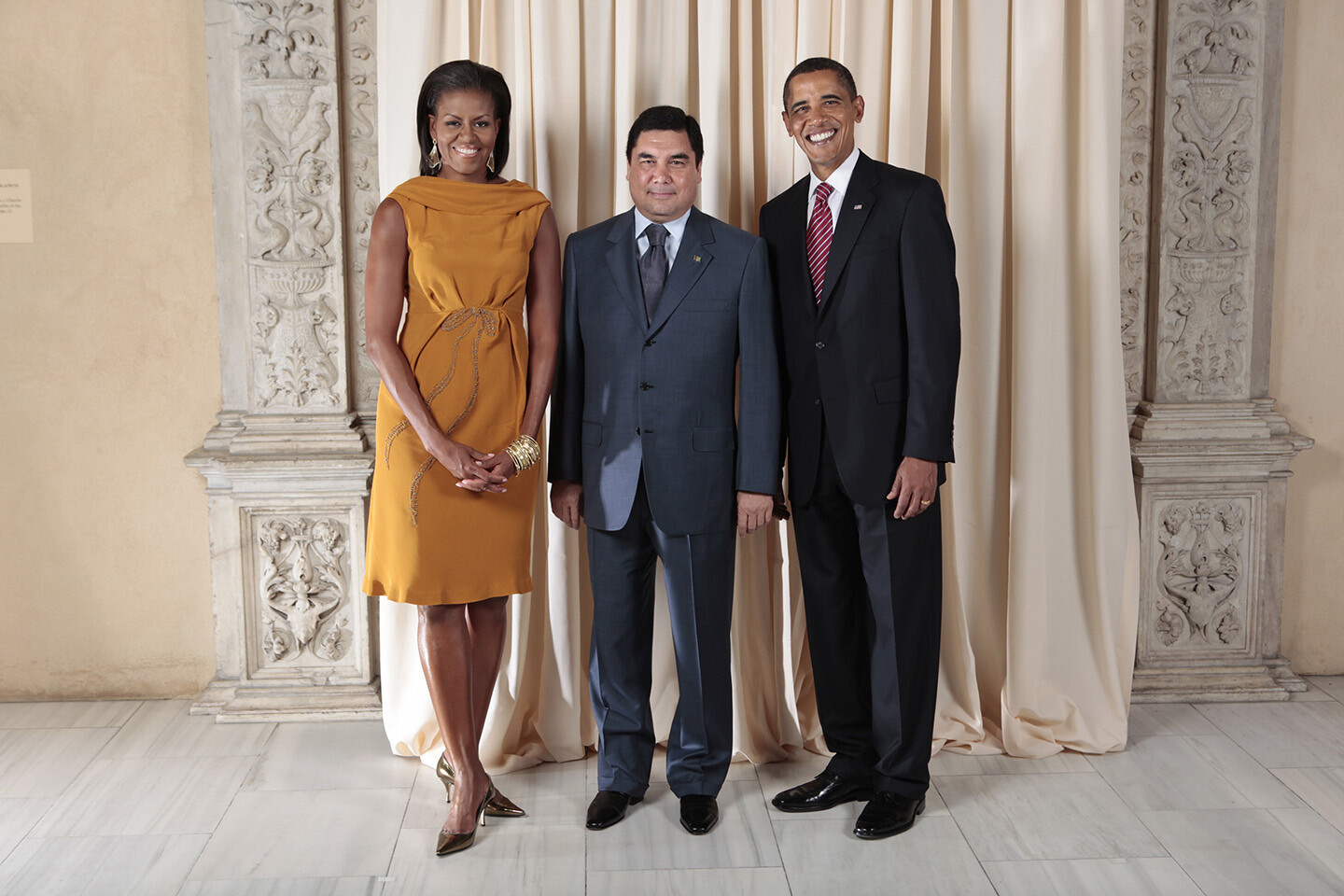
Separmurat Niyazov with Barack and Michelle Obama. License: Public Domain
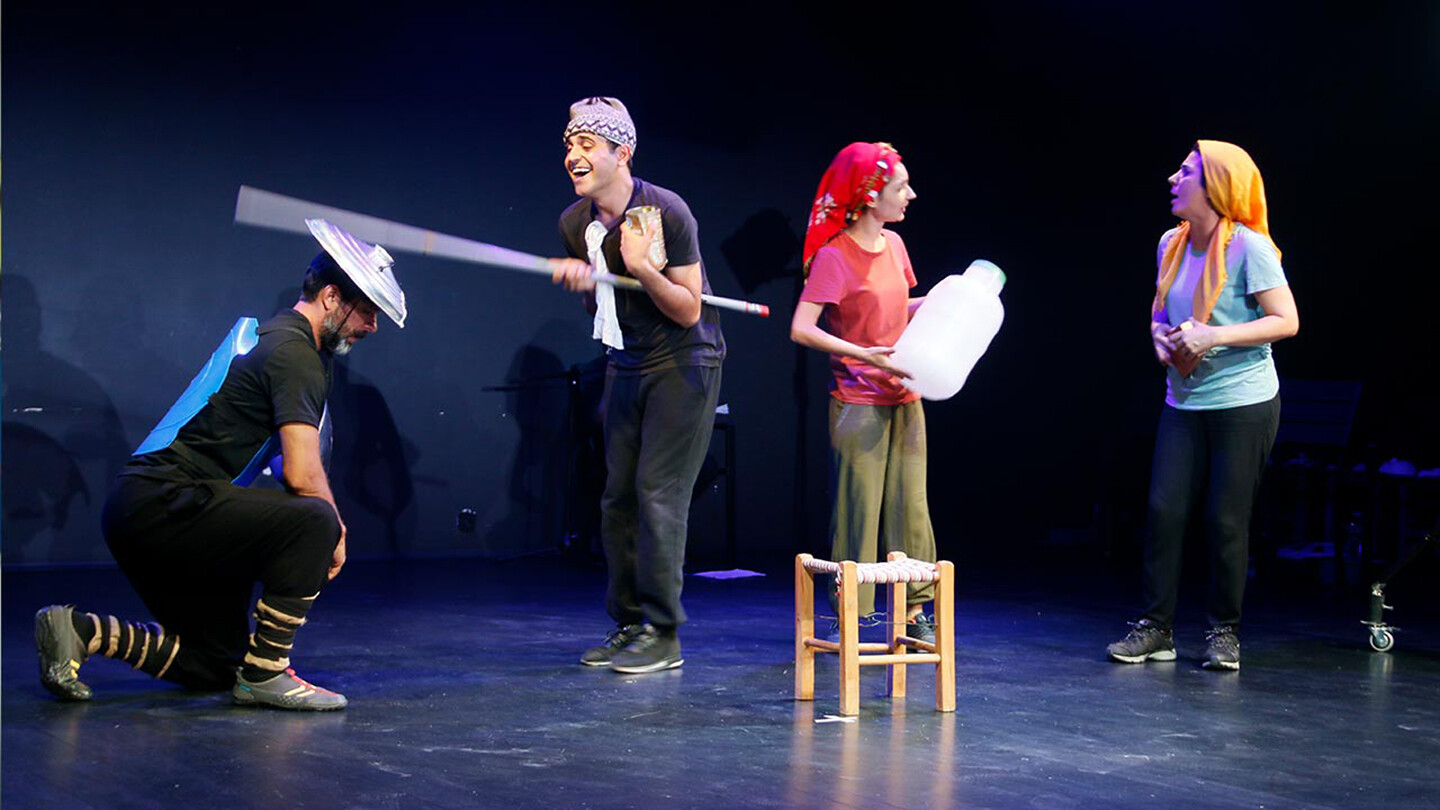
Actors from the Amed Municipal Theater in Diyarbakır (Amed) performing a previously banned Kurdish-language adaptation of Cervantes’s famous Don Quixote in Kartal, Istanbul, 2022.
Separmurat Niyazov with Barack and Michelle Obama. License: Public Domain
––––East Timor gains independence from Indonesia and reinstates Portuguese, along with Tetum, as the official language, in an attempt to differentiate from Indonesia.
2003: The ban on use of the letters Q, W, and X, necessary for writing Kurdish names, is lifted by the Turkish government.
2004: The first broadcast in Kurdish on the Turkish state TV channel TRT. Prior to this, programs in the Kurdish language were only broadcast on private channels. Two dialects are broadcast: Kurmanji and Kırmancki/Zazaki.
––––Latvia requires at least 60 percent of school instruction to be in Latvian.
2005: In Turkmenistan, all Russian schools are shut down due to apparent lack of demand. Instruction on the Russian language is reduced to one hour per week. Russian-language media is entirely banned.
––––Irish is made an official language of the EU, though it remains the least routinely spoken.
2006: AfriForum, a white nationalist NGO promoting the use of Afrikaans, is formed.
––––The European Parliament’s Bureau approves a proposal by the Spanish government to allow citizens to address the European Parliament in Basque, Catalan/Valencian, and Galician.
2008: A revision to the French Constitution, according to which regional languages are formally recognized, is implemented by the French Parliament. The move angers the Académie Française.
2009: Slovakia limits the use of Hungarian and other minority languages in public and in state institutions and enacts fines for anyone “misusing” language.
2010: Mass protests erupt in Guangzhou in response to the proposal for the city’s principal television channel to switch from Cantonese to Mandarin.
––––The Indian state of Haryana removes Tamil as an official language and replaces it with Punjabi.
2014: The Russian Federation occupies Crimea.
––––Narendra Modi comes to power in India, igniting a spike in anti-Urdu sentiment that includes hate crimes targeted at those with Urdu names.
2015: All Tibetan schools are forbidden to recruit teachers who teach in the Tibetan language.
2017: A draft of a new Latin-based alphabet is presented in the Parliament of Kazakhstan, a gradual transition that is expected to be complete by 2025.
––––The Turkish government shuts down Kurdish-language theaters in Diyarbakır, Batman, and other majority-Kurdish cities.
––––Ukraine passes legislation that requires teachers to use only Ukrainian in secondary schools, despite sizable Hungarian, Russian, and Romanian minorities. Hungary responds by threatening to block Ukraine’s EU aspirations.
2018: Documents issued by the government in Kazakhstan are to be published only in Kazakh.
––––In Latvia, the Saeima approves amendments to the General Education Law for a transition to instruction in Latvian in secondary schools by the 2021–2022 school year.
––––South Korea bans English-language classes for first and second grade students, citing a 2016 Constitutional Court ruling that states that teaching English may hinder students’ proficiency in Korean.
––––Israel downgrades Arabic as an official language and declares it a language with “special status.” Meanwhile, Hebrew remains official.
––––Iran bans the teaching of English in primary schools, calling the study of the language a “cultural invasion.”
2019: Mass protests in Hong Kong expressing dissatisfaction with Chinese rule. Cantonese is closely connected with the unrest and becomes the language of the protestors. Some restaurants in Hong Kong refuse to take orders in Mandarin as a sign of protest.
––––Ukraine’s Parliament approves a law that grants special status to the Ukrainian language and makes it mandatory for public sector workers.
2020: The government of China passes a new security law for Hong Kong. Within hours of its passage, many anti-government protestors flee the city, political parties are disbanded, numerous pro-Hong Kong social media profiles are deleted, and pro-Cantonese posters in shops are removed. Any defense of Cantonese is seen as promoting Hong Kong’s independence.
––––India, for the first time since independence, stops offering primary schools where the main language of instruction is English.
––––In Iran, authorities sentence Kurdish language teacher Zahra Mohammadi to ten years in prison for “forming a group against national security.” The sentence is later reduced to five years.


Zahra Mohammadi makes the victory sign as she registers her candidacy for the upcoming presidential election at the interior ministry in Tehran on Shandiz May 11, 2013. Photo: Mohsen Shandiz/Corbis via Getty Images
2021: The Molac Law aiming to protect and promote regional languages in France is approved by a majority vote in the French National Assembly. The French Constitutional Council immediately contests the law, striking down the Assembly’s vote. The Constitutional Council forbids the use of the letter ñ, which is not necessary for writing in French.
This timeline was originally developed as part of a presentation of the film Gilgamesh: She Who Saw The Deep, by Pelin Tan and Anton Vidokle. The film was shot in Kurdish language (Kurmanji) in South East Turkey, where it is illegal to speak it in public spaces.
